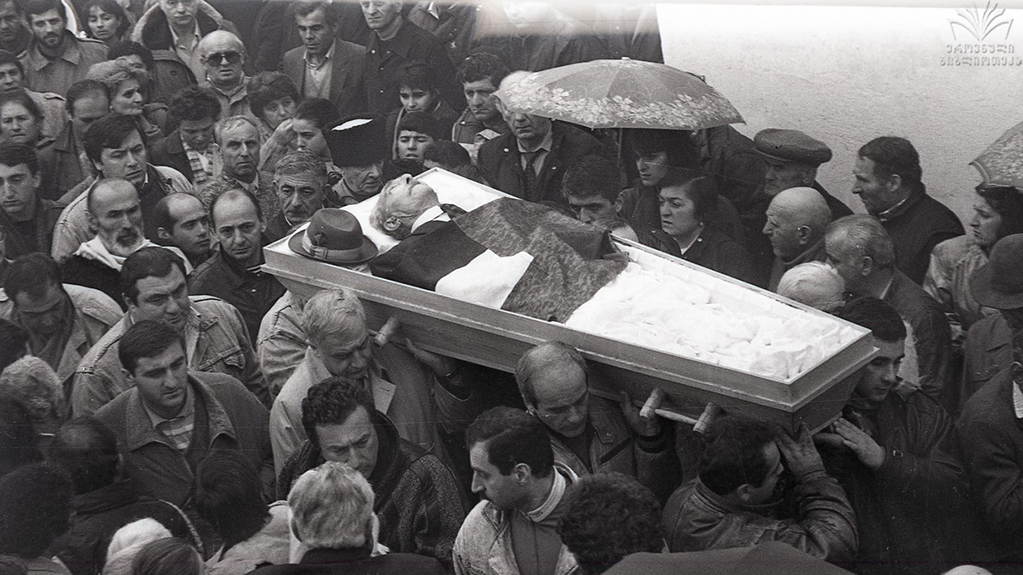The remains of Alexander Sulkhanishvili, a comrade of Kakutsa Cholokashvili and a member of the Sworn Squad, who was buried in the yard of Tetri (White) George Church near the bell tower, were exhumed by the order of the Alaverdi Metropolitan and relocated to the back of the church. The grave, originally arranged by the order of national liberation movement leader Zviad Gamsakhurdia, was completely destroyed.
News
Trending stories
- 1 BBC investigation: WWI–Era Chemical Weapons Used to Disperse Tbilisi Protests
- 2 Starting in 2026, First-Year Students at Private Universities Will No Longer Receive State Grants
- 3 NGOs Demand Answers on Which Chemical Substances MIA Used Against Protesters
- 4 Kobakhidze and Putin Attend International Forum on Neutrality in Turkmenistan
- 5 Zurabishvili Appeals to International Organisations to Investigate Possible Use of “Camite”
- 6 The Strasbourg Court Has Begun the Substantive Hearing of Gela Mtivlishvili's Case
"It will probably be a year. I don't know exactly. That's better, the clergy said.
This has been agreed upon with the authorities at a high level. Reverend David will not anything without that,"
Giorgi Lomiashvili, the dean of Tetri Giorgi Church told us.
We asked the head of the church, Ioseb Gvinianidze, about the necessity of removing Alexander Sulkhanishvili's remains and relocating them to another spot at the back of the church, as well as erasing the traces of the grave arranged by Zviad Gamsakhurdia and with his involvement. He responded, "The grave was dismantled. Why are you interested in it? You should ask whoever made the decision."
The decision was made by the Metropolitan of Alaverdi, Abba Alaverdeli, who is also the chairman of the Architecture and Art Center of the Patriarchate. Despite a written appeal to the Metropolitan and the Patriarchate of Georgia, we were unable to receive an explanation.
The Tetri Giorgi Church, the bell tower, and the rampart are also cultural heritage monuments. For this reason, we requested information about the works carried out in the complex from the National Agency for the Protection of Cultural Heritage. In addition to the removal of Alexander Sulkhanishvili's remains and the destruction of the grave, the gate in the fence, which had monument status, was removed, and a new one was built in its place. The wall on the lower side was demolished, and a new entrance was created to allow cars to enter and arrange covered parking. A new area was built adjacent to the bell tower, exactly where the grave of Alexander Sulkhanishvili had been. Despite the expiration of all deadlines established by law, the agency did not provide us with any information.
It is important to note that the so-called rehabilitation works at Tetri Giorgi Church were carried out by Jikha LLC, under the order of the Georgian Historical Monuments Protection and Rescue Fund, which is connected to Bidzina Ivanishvili's Cartu Foundation. The owner and director of Jikha LLC is Paata Nutsubidze, who previously demolished the 10th-century Korogho Tower, a cultural heritage monument in the Khada Valley. Paata Nutsubidze did not respond to Mtis Ambebi's questions about the works carried out at the Tetri Giorgi Church complex.
Alexander Sulkhanishvili was born in 1896 in the village of Atskuri in Kakheti. He served in the Georgian National Army from 1918 to 1921. After the occupation and Sovietization of Georgia, he fought in the detachment of the sworn soldiers of Kakutsa Cholokashvili and became one of Kakutsa's deputies.
Sulkhanishvili participated in the August 1924 uprising, and after its defeat, Kakutsa Cholokashvili and other members of the squad moved to Turkey, where they spent 66 years in exile.
In the early 1950s, Alexander Sulkhanishvili became an active member of the Georgian community in America. He withdrew from community activities after moving to San Francisco, California.
During his emigration, he published the following books: The Voice of Truth: The Actions of the Reds in the Georgian Community of New York (Munich, 1962, with St. Archil Metreveli); Memoirs of the Sworn Squad, 1922–1924 (San Francisco, 1981); What Happened Between the Georgians in Metekhi Prison in 1923 and 1924 and the Truth about Ilia's Murder (San Francisco, 1985); My Answer to Zhordania's Successors (San Francisco, 1987); The Life of the Sworn Squad in France from November 1924 (San Francisco, 1987).
Kakutsa Cholokashvili's valuable sword was kept with him and later returned to Georgia. With the help of journalist Paata Natsvlishvili, Alexander Sulkhanishvili, at the age of 94, returned to his homeland on October 19, 1990. He brought with him a small package labeled Georgian Land. He lived in Georgia for only 18 days.
According to his will, the Georgian land that Sulkhanishvili carried with him during his 66-year exile was placed on his heart when he was buried in the fence of the Tetri Giorgi Church in his native village, Atskuri.
Also, by his will, the newly elected Parliament of Georgia was presented with the flag of the Democratic Republic, which Kakutsa had held before his death. This flag, along with Kakutsa’s sword and belt-dagger, is currently housed in the National Museum of Georgia.
"Today, Georgia is honoring a great Georgian, a comrade-in-arms of our national hero, Kakutsa Cholokashvili - Alexander Sulkhanishvili, who was martyred for Georgia. This is a great sacrifice, brothers and sisters, made by the Sworn Squad soldiers for our land... Truly, Georgia is fortunate today. It has shaken off the yoke of Bolshevik slavery, embraced its noble son, and held him dearly in its heart. Because of the twists of fate, it could not see what it fought for, what it struggled for, and what the sworn enemies sacrificed themselves for. But he saw the daybreak, he saw the dawn of that glorious new day, which is called the freedom of Georgia, which is called the independence of Georgia," said Zviad Gamsakhurdia at the funeral of Alexander Sulkhanishvili. By his own order, the grave of the Sworn Squad member was arranged, and a bust was erected.
"After 30 years, this grave can be seen as a cultural heritage, and treating it in such a crude and disrespectful manner can only be described as vandalism,"
says historian and researcher of the Soviet past, Irakli Khvadagiani. "In general, such relocations raise ethical issues, especially when the reason is unclear. There might be a pressing need if, for example, the grave itself is threatened with destruction or something strategic is being constructed on the site. But in the yard of a single church, where there seems to be no such urgent need, and with the grave moved elsewhere without informing anyone, it’s a different matter. This tomb complex was damaged and destroyed. To me, it's vandalism."
"The problem of the disappearance of history," is how Nodar Aronishidze, an architectural historian and employee of the Giorgi Chubinashvili National Research Center for the History of Georgian Art and the Protection of Monuments, describes the destruction of Alexander Sulkhanishvili's tomb.
"This is not only about cultural heritage. This concerns the country's recent history. First, the figure himself is significant, and then the person who attended his funeral. It shows the civil aspect when Zviad Gamsakhurdia himself is seen in photographs laying Alexander Sulkhanishvili to rest. The grave's arrangement was thoughtfully crafted in the context of modern art and sculpture. It was a carefully constructed design, planned and assembled by an architect to honour this individual as best as Georgia and its president could at that time. The tomb bore bullet marks - this, too, was part of its historical significance. Now, everything is gone - the structure of the tomb has disappeared, and even the bust is no longer visible.
The grave recently constructed next to the temple in no way reflects what once held historical significance and embodied the memory and tragic history of our country."
Zviad Gamsakhurdia's son, Konstantine Gamsakhurdia, called the destruction of Alexander Sulkhanishvili's grave an act of vandalism but declined to comment on the video.















